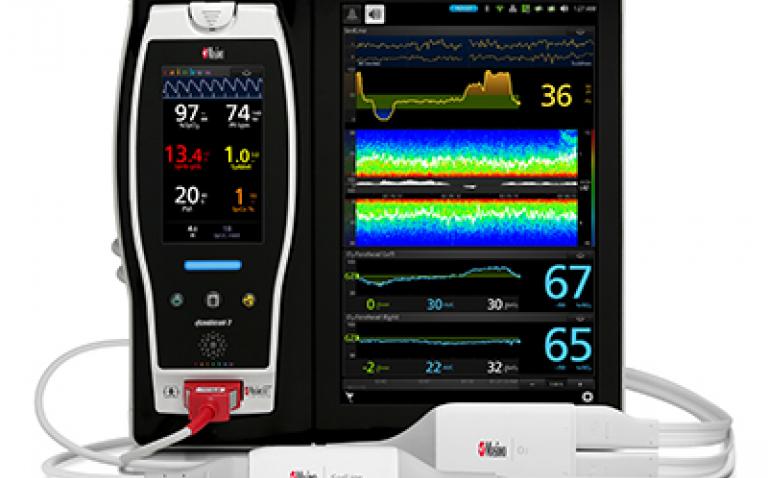Masimo has announced the use of Masimo technologies – O3® regional oximetry and SedLine® brain function monitoring – in two abstracts presented at the 2018 Annual Meeting of the International Anesthesia Research Society (IARS). Both studies investigated links between postoperative delirium and particular biomarkers.
In the first study1, Dr. Aymen Benkreira and colleagues at the Montreal Heart Institute sought to identify a possible link between venous congestion from right ventricular failure and postoperative delirium after cardiac surgery. As a proxy for venous congestion, they investigated whether there was a link between portal vein pulsatility (evaluated by point-of-care Doppler ultrasound) and postoperative delirium and associated features. In addition to daily cognitive and delirium evaluations for five consecutive days, the patients were evaluated for asterixis and bilateral cerebral oximetry values using Masimo O3. Of the 145 adult patients enrolled in the study, an abnormal cognitive status was identified in 36.9% of assessments and portal vein pulsatility in 42.3% of assessments. The researchers found significant associations between portal pulsatility and:
- the development of cognitive dysfunction (odds ratio of 2.10, confidence interval of 1.25-3.53, p=0.005)
- the development of asterixis (OR of 2.23, CI of 1.13-4.41, p=0.02)
- a more than 15% decrease in cerebral oximetry values from pre-operative baseline (OR of 2.23, CI of 1.12-4.71, p=0.02).
The researchers concluded, “This data presents for the first time an association between an objective sign of portal hypertension of cardiac origin and delirium in cardiac surgery patients. This suggests that delirium may have a congestive origin in some patients.”
In the second study2, Reine Ibala and colleagues at Massachusetts General Hospital sought to identify EEG biomarkers that could aid clinicians in preemptively identifying patients at risk for postoperative delirium. Such biomarkers – particular alpha and beta band oscillatory dynamics that may reflect the robustness of cortical circuits underlying cognitive processes – are commonly present in patients with clinically diagnosed cognitive impairment (dementia). The researchers theorized that there might be a link between dementia and postoperative delirium and thus also between postoperative delirium and cognitively normal patients whose EEG data exhibit similar biomarkers under anesthesia. They analysed EEG data, collected using Masimo SedLine brain function monitoring, from 24 patients (21 cognitively normal, 3 with dementia). Analysis demonstrated a significant association between EEG point estimates for alpha/beta power and dementia (odds ratio of 1.43, 95% confidence interval of 1.14 to 1.79). Postoperative delirium for cognitively normal patients was associated with “visually evident decreased alpha/beta power,” passing the threshold of statistical significance.
The researchers concluded, “Decreased alpha/beta oscillation power during sevoflurane general anesthesia is strongly associated with known cognitive impairment. This dynamic may be used to develop principled neurophysiological-based approaches to aid the preemptive identification and care targeting of vulnerable patients. Cognitively normal patients who developed postoperative delirium demonstrated a similar neurophysiological profile – but to a lesser extent – compared to patients with dementia to suggest that postoperative delirium may be more closely associated with sub-clinical cognitive impairment than previously appreciated.”
SedLine brain function monitoring helps clinicians monitor the state of the brain under anesthesia with bilateral acquisition and processing of four leads of electroencephalogram (EEG) signals. Next Generation SedLine, recently released, features an enhanced signal processing engine, driving a variety of performance improvements, and an enhanced Multitaper Density Spectral Array (DSA). Next Generation SedLine can be used simultaneously with O3 regional oximetry on the Root® patient monitoring and connectivity platform for a more complete picture of the brain. O3 may help clinicians monitor cerebral oxygenation of adult and pediatric patients in situations in which pulse oximetry alone may not be fully indicative of the oxygen in the brain.
References
- Benkreira A, Beaubien-Souligny W, Denault A, and Mailhot T. Postoperative delirium and hepatic venous congestion: a prospective study. Proceedings from the 2018 IARS Annual Meeting, Chicago, Illinois. #1470.
- Ibala R, Hahm, E, Maher S, Nebreda M, Garcia E, Nozari A, and Akeju O. Decreased EEG alpha/beta power during sevoflurane general anesthesia is associated with pre-existing cognitive impairment. Proceedings from the 2018 IARS Annual Meeting, Chicago, Illinois. #1173.










